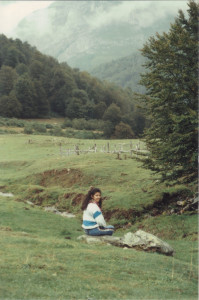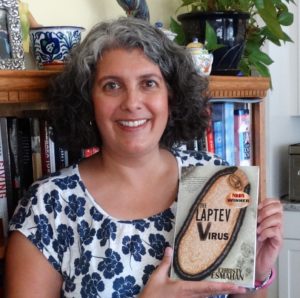Ever held back, afraid, and later realized that your fears were misplaced and you missed out on an interesting experience? Living in Spain, especially that first year, was a series of adventures, most of which I enjoyed thoroughly. But this particular outing happened very early in my stay, and I had not yet learned to trust and to let go of my American hesitations.

I love the mountains in Spain–when I was in grad school we went practically every weekend on an excursion to different mountains.
“Come on! It’ll be fun! We’ll go early in the morning and we’ll get lots of them—you’ll see.”
Finally allowing myself to be convinced—I was exhausted from the week of research and classes and had looked forward to sleeping in late and catching up on my letter writing—I acquiesced.
At 6:00 a.m. sharp we met outside, our breaths forming shimmering ghosts in the chilly October air. We piled into someone’s car—there were three cars altogether–and drove for about an hour, up the winding roads toward the nearest mountains, the Picos de Europa. It was someone’s “secret spot” I later found out—everyone had places where they knew they could find the best ones, and consequently kept their locations hidden from others.
Once we had climbed the rocky slopes for a bit and had entered a forest of umbrella-shaped pine trees with twisted trunks, which in the gray early morning mist made me wonder how close we were to Transylvania, everyone separated and began scouring the ground, gingerly sliding wet clumps of russet-colored pine needles out of the way with the tips of their boots. Moistness seeped into my sweater and would have chilled me more if I hadn’t been trying to keep up with my fast-walking companions.
“Look, here’s a real beauty,” said one of my friends, holding up a brownish yellow mushroom, not too unlike a portabella in his broad hand.
“Ooh, it’s a Níscalo! Here, Christy, smell it,” said a pretty girl who lived down the hall from me, breaking a piece off and holding it close to my face.
I was surprised by the fruity smell, wholesome and rich. “What will you do with it?” I asked, fearing the answer. I had never seen anyone use hallucinatory mushrooms, but then again, I’d had a pretty sheltered life before I went to Spain.
“We’ll cook them when we get home. I love tortilla de setas,” she exclaimed.
Still wondering, I asked another friend, one whom I could trust to answer me without laughing at my ignorance, and she assured me that the setas we were hunting for today were for regular food.
I breathed a sigh of relief and continued following different people around as they stooped, examined the fungal morphology of each new seta, occasionally consulting with each other or scowling over a small paperback book whose corners were curled and dirty, and gradually filled several plastic grocery bags with their treasures.
“Too bad it’s not the time of year for the seta de San Jorge,” one boy said, “I love those!”
“Here’s a really cool seta de caña,” another boy said, holding up a mushroom that looked like an umbrella blown inside-out in a windstorm.
“And over there I found some setas de cardo,” said still another girl, pointing to some broad, steel-gray hooded ones with large, thick stems.
Nowadays they recommend that you only use wicker baskets to collect mushrooms in order to keep the setas from spoiling, and a special license is required in order to preserve natural habitats from over-harvesting, according to a cool blog post I found on the subject (1). This blog has a lot of information on where and how to hunt for mushrooms and some good pictures. I’ve also added several other links below with pictures of mushrooms that can be found all over Spain. Who knew it was such a huge past-time there?
After a full day, including a picnic lunch and stop for a warm cup of broth at a small restaurant, we headed back to my friend’s apartment. The mushrooms—at least 15 different kinds–were sorted under a bright light to be sure that there had been no confusion that would end up poisoning everyone. They looked at stem thickness, length, color, shape, whether there were notches or ridges, and then proceeded to do the same with the mushroom caps, smelling them occasionally and discarding any dubious ones. Then they washed them and chopped them up and made a series of omelets, laughter and songs ringing out as they banged pots and plates in the under-sized kitchen and sipped scarlet goblets of wine. After about 45 minutes, everyone sat down to eat them with gusto. Everyone, that is, except me. Still very shy and overly wary, I did not join in, falsely claiming that I just didn’t like mushrooms.
When I saw that everyone was healthy and hardy the next day (I had honestly expected some of them to at least be vomiting) it dawned on me how foolish I had been to be so frightened. I wish I could say that I learned my lesson and was never afraid again, but that’s not how it works, is it? Sure, over time I did learn to trust a bit more, and I had many wonderful adventures that I might otherwise have missed if I had continued to always be hesitant to try new things. But, oh, those mushroom omelets—my mouth still waters as I recall their smell and I do wish I had not been so timorous!
(1) http://blog.ruraldir.com/turismo-micologico-donde-recoger-setas/
Here are some links to mushrooms that grow wild in the mountains of Castilla y Leon:
http://www.arauzodemiel.org/setas.htm
http://centros4.pntic.mec.es/ies.de.cistierna/alumnos/04_05/alvaro/alvaro/Barbuda.html
http://www.cestaysetas.com/informacion-micologica/guia-de-setas/
If you enjoyed this blog post, you might also like my series of novels, Bueno, Sinco and Brujas, which takes place in Santander, Spain.



2 comments
Me encantan tus escritos. Puedo imaginarme hasta el paisaje cuando los leo. Increibles experiencias y recuerdos.
Author
Muchisimas gracias, Claudia! 🙂